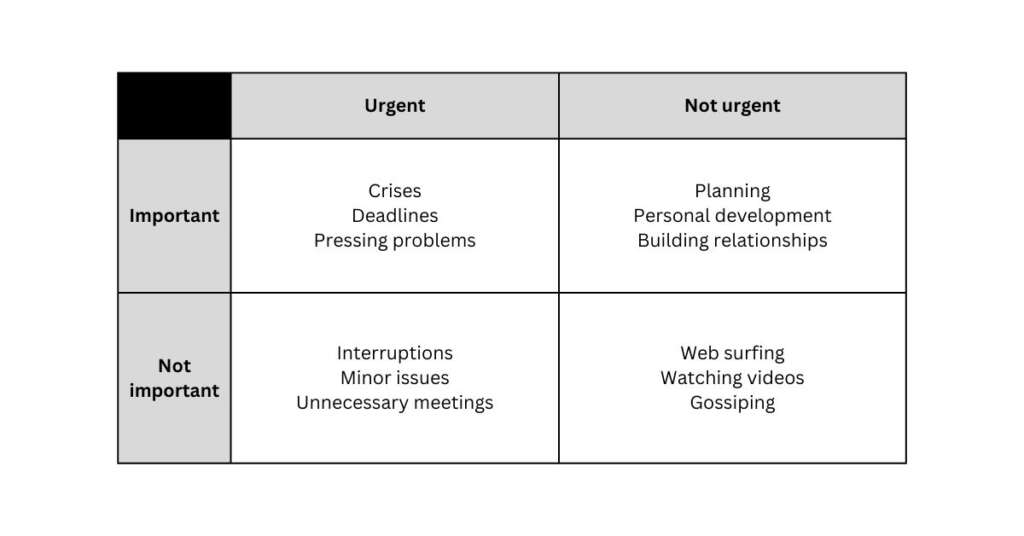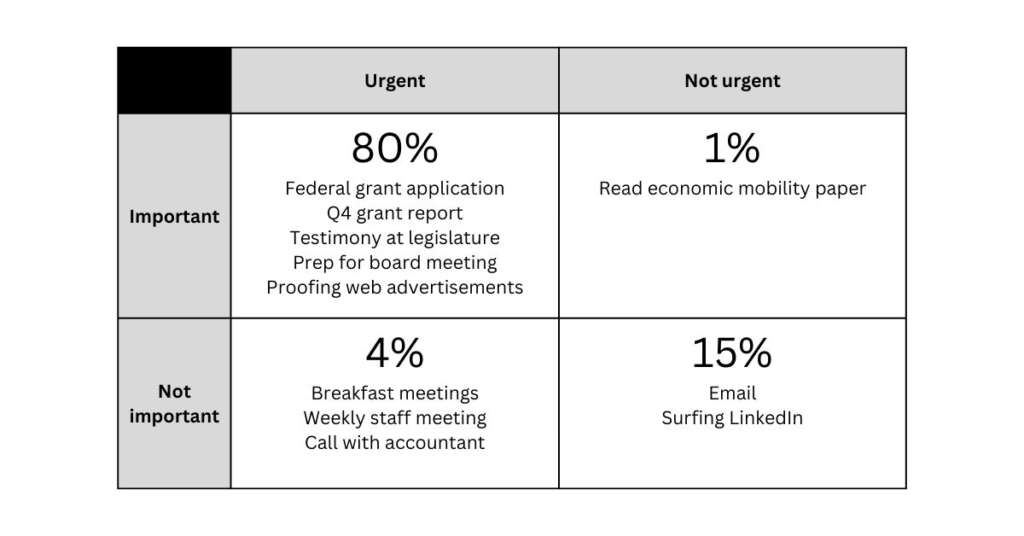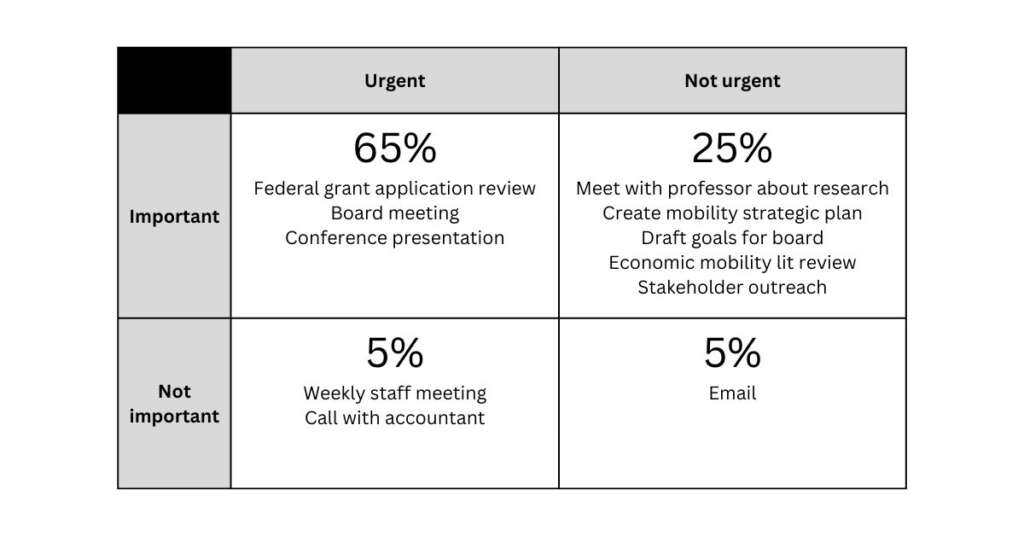About a year ago, I had a consulting session with Francine Jenkins about improving her focus and time management. (This isn’t her real name – I’ve changed a few minor details in this story to protect confidentiality.)
Francine has led a public-private partnership related to economic development in a major American city for the last 5 years. She’s a mid-career professional and seems to know all the CEOs, county commissioners, and other major players in her metro area.
But, Francine was facing an all-to-common challenge: there weren’t enough hours in the day for all of her To-Do’s.
Five days a week she would wake up at 5:15 a.m. to comb through emails, hold an early breakfast meeting, and then head to the office for a 10-hour day. Most evenings were taken by nonprofit board meetings for which she volunteered.
Even though she insisted that she loved being super busy, she felt like she wasn’t making enough progress on “the big important problems that brought me to this work in the first place.”
She worried that another 5 years would go by without making any progress on “the really important stuff…you know, the deeper problems, like reducing poverty and increasing economic mobility.”
In today’s issue, I’m going to share our discussion, my recommendation, and the results.
Francine’s biggest challenge: Days full of urgent requests
Francine and her organization had been talking about increasing economic mobility in the region for about three years, but they weren’t addressing the issue directly.
So I asked her to walk me through what actions she was taking each week to work on the issue.
Here was her answer:
“Everything I do is related to it…like this big federal grant that was just announced. We’re asking for a few million to increase economic mobility.”
So what would the grant money be used for, I asked?
According to Francine, that hadn’t yet been determined.
As we went deeper into her schedule, most of her activities were responses to urgent requests from others. Like, “come to this board meeting to talk about your organization”, or “can you be a partner on this new grant opportunity?”
“My schedule is full every day,” she said, “but other than talking about why the issue of economic mobility is important, I’m not doing very much to directly affect it.”
How much time, I asked, did she set aside to work on economic mobility every week?
Usually just the commute home on Fridays, she said. About 25 minutes while stuck in stop-and-go traffic.
“It’s a dreadful feeling to be exhausted from another week and feel that no actual progress has been made.”
It’s so common, and I hear it from changemakers all the time.
More time talking about aspirations than pursuing them.
Promoting the organization more than executing the mission.
Days of meetings rather than building relationships.
It doesn’t have to be that way.
My recommendation: Track your time with the Urgent-Important Matrix
I told Francine that she should track her time for one week.
To do that, we used Stephen Covey’s Urgent-Important Matrix.

It’s a tool for categorizing tasks based on their urgency and importance. The matrix is divided into four quadrants:
- Urgent and Important: Tasks that require immediate attention, such as crises or deadlines.
- Not Urgent but Important: Tasks that contribute to long-term goals, such as planning, building relationships, or personal development.
- Urgent but Not Important: Tasks that distract from long-term goals, such as interruptions, minor issues, or unnecessary meetings.
- Not Urgent and Not Important: Tasks that are time-wasters, such as aimless web surfing, watching videos, or gossiping.
By categorizing tasks into these four quadrants, Covey suggests that we can prioritize our time and focus on tasks that contribute to our long-term goals, while minimizing distractions and time-wasters
For those who haven’t ever used it, the Matrix seems ridiculous.
Why, for example, would people spend time on unimportant things?
But our schedules and activities tell a different story.
Most of us spend an inordinate amount of time on urgent and important – but not mission critical – matters.
- “Please respond to this email ASAP!”
- “Could you be a guest presenter at our meeting this afternoon?”
- “This grant needs a letter of support and it’s due at 4pm – can you write it?”
After one week
Here’s a high-level summary of how Francine’s time looked after one week:

About 80% of her time went to things that were Urgent and Important. These were mostly deadline-driven projects, but they were reactive to what other people thought important. And, they didn’t directly address economic mobility.
When she started to feel burned out about mid-week, she escaped to less demanding tasks in the Not urgent and Not Important quadrant.
Francine identified surfing LinkedIn as a guilty pleasure that distracted her from the rest of her crisis-driven schedule.
She could only identify that she’d spend about 35 minutes on something Not Urgent but Important: reading a new peer-reviewed research study about factors driving upward mobility for low-income families.
What if?
After we reviewed how she spent the previous week, Francine commented on how she was spending most of the week running from problem to problem.
She asked,
“How can I solve more problems quickly so that I can spend more time on Not Urgent but Important tasks?”
Perhaps, that was the wrong way to think about it, I wondered aloud.
I shared one of my favorite quotes from Stephen Covey:
“Effective people are not problem-minded; they’re opportunity-minded. They feed opportunities and starve problems.”
I wanted Francine to think about investing in the best opportunities for long-term impact rather than about getting more efficient on urgent but not mission critical tasks.
What if she planned Not Urgent but Important tasks into her schedule first – by blocking time on her calendar – and then let other tasks and appointments fill in around it?
Francine said she’d think about it and we’d check in the following week.
The results: 25x more time on what’s most important
At our next consulting appointment, Francine couldn’t wait to tell me about how she’d spent her time.
“I increased the time I spent on Important but Not Urgent tasks by 25 times!”
I almost couldn’t believe it.
Here’s what the new time breakdown looked like:

She’d proactively spent about 15 hours working on economic mobility issues, including planning, goal creation, and relationship building.
It’s an investment that, when compounded week after week, will lead to transformational change and impact.
Not bad for just two consulting calls.
It’s rare for my clients to transform their time as much as Francine, but nearly all of them can significantly increase their time on Not Urgent but Important matters.
And, deep down, most want to make the schedule anyway.
It’s less boring.
And they finally get to spend time on what they think is most important.
If you’re interested in making more impact, like Francine and her organization that is now making serious progress on economic mobility, consider one-on-one coaching with me.
I hope you found this case study helpful.
See you again next week.
==
Whenever you’re ready, there are two ways I can help you:
→ I’m a strategic advisor for the toughest societal problems like poverty, crime and homelessness. People come to me when they want to stop spinning their wheels and get transformative, systems-level change.
→ I’m a coach for emerging and executive leaders in the social and public sectors who want to make progress on their biggest goals and challenges.
Let’s find out how I can help you become transformational.



